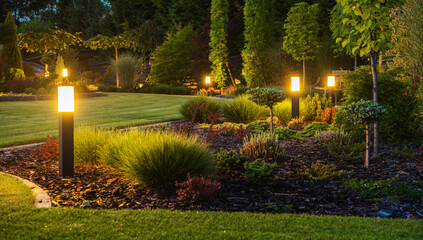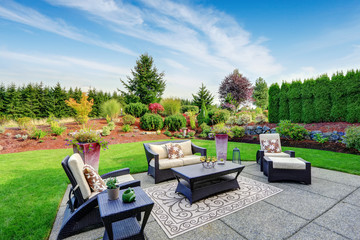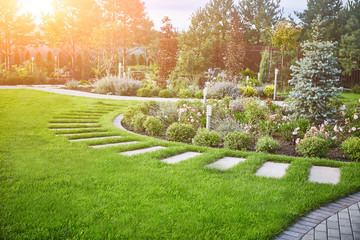
Landscape lighting helps your yard stand out after dark. It can illuminate a patio for evening entertaining, highlight the architecture of your home, or add curb appeal to a water feature or garden.
When choosing lights, consider maintenance needs. Hardwired fixtures require professional installation, while solar and battery-operated lights can be a do-it-yourself option. Click Here to learn more.
Whether you’re hosting a dinner party, grilling a steak with friends or curling up on the sofa with a book after a long day, the mood of your outdoor space can make or break the experience. Harsh overhead lights can ruin a romantic setting, detract from a clean look and create safety hazards on walkways. Using soft landscape lighting to create a pleasing ambiance will enhance your landscape, increase enjoyment and add value to your home.
A professional lighting designer can help you choose the right fixtures to light your yard, patio or pool area. Unlike traditional ceiling or wall lights, landscape lighting is separate from your home’s wiring and uses a low voltage system. This means your yard will be safe, hazard-free and easy to use after dark.
Landscape lighting comes in a wide variety of styles, including path, spot and floodlights. You can use them to highlight different elements in your landscape, such as trees, plants, a water feature or a sculpture. Some styles are designed to look like high-end indoor lighting, which gives your exterior a more polished look.
There are also ways to use lighting to enhance the color of your landscaping. Brighter white LED bulbs produce a more crisp look, while warmer tones that mimic natural sunlight or an open flame will create a soft glow.
Having the right lighting can make your yard come alive at night. You can use it to showcase your favorite plants, create a relaxing atmosphere and even show off your personality. With the new generation of smart LED lighting, you can schedule your lights to turn on and off at specific times or set them to flash in a particular color for holidays and special occasions.
The most common types of landscape lighting are pathway, spotlights and well lights. These are low-voltage systems that work on a step-down transformer to reduce the 120-volt household current to a safer 12 volts. They’re often installed in concrete or pavers, and they can be hidden in the ground so they don’t detract from your curb appeal.
Accent Lighting
Landscape lighting can add a dramatic effect to any outdoor living space. It can highlight certain features of a garden, water or fire feature or a home or property boundary at night. It can also help guide people safely through pathways and other structures, as well as make it easier for guests to navigate around your yard.
With its glare-free accent lights and three color options, this LED landscape lighting set is ideal for creating a warm and welcoming ambiance around your garden, driveway, patio or porch. Each fixture emits 100 lumens and produces a soft, natural light, while the adjustable beam angle makes it easy to focus on specific areas of your outdoor spaces. You can also change the bulbs to fit the occasion or season.
Another option for landscape lighting is to use up-lighting, which involves shining light upward onto the feature you wish to illuminate. While this can be an effective way to add visual interest, it’s important to keep in mind that up-lighting can cause light pollution, which can have negative environmental and health impacts.
If you’re looking for a more dramatic look, try using silhouette lighting, which is achieved by washing the background of a landscape feature with a soft light and then accenting it with a spotlight. Some of the most stunning examples of silhouette lighting come from dense landscape features like tall evergreen shrubs, trellises or even the facade of a building.
Adding a touch of drama and making your landscape features more prominent at night can improve the overall beauty of your outdoor spaces and invite guests to stay and relax well into the evening. This is why it’s so important to choose the right landscape lighting for your home and to take advantage of the different techniques available for enhancing the beauty and functionality of your outdoor spaces.
Whether you’re lighting up walkways, highlighting architectural features or illuminating your favorite plants and trees, landscape lighting is an investment in the safety, security and curb appeal of your property. It allows you to enjoy the beauty of your outdoor spaces and extends their usability, enabling evening gatherings, relaxation and safe navigation.
Ambient Lighting
A landscape light is an important component of the overall look and feel of a property, both at night and during the day. You can choose from several styles of lights to suit your needs, from simple LED landscape floods to decorative sconces and porch lanterns. There are also low-voltage options for paths and walkways that help guests safely navigate your yard during the dark.
A well-lit exterior can set a warm, welcoming tone that welcomes family and friends after the sun goes down. In addition to adding visual interest, a well-lit entryway helps prevent accidents caused by poorly-lit stairs or paths. For an added touch of flair, consider a high-end fixture that looks like a fancy indoor lantern or sconce to heighten the appeal and sophistication of your home’s architecture.
Uplighting is a great way to create drama with taller structures such as trees or trellises, and it also works well to highlight an architectural detail on the side of your house. When shopping for landscape lighting, look for a light with a higher efficacy rating than a standard bulb—the amount of lumens it produces per watt. This will help you save on energy costs over time.
If you want to wash a space with light, try a fixture that emits a wide beam angle. This will allow the light to cast a soft glow over the entire area, eliminating shadows and creating a uniform appearance. You can also add a few spotlights to illuminate features that are particularly attractive or significant, such as a statue or waterfall.
Other landscape lights include recessed lighting that can be installed in the ground to accentuate an architectural feature or pathway, as well as path and driveway lights to help guide family members and guests around your property at night. For a truly customized approach, you can even use smart bulbs that are compatible with Alexa and Google Home to control your landscape lighting with voice commands.
To complete your landscape lighting system, you’ll need a transformer that converts line voltage down to 12-volt AC power for the lights. You’ll also need wire and wiring connectors to carry the power from the transformer to each of the lights in your yard.
Path Lighting
One of the first types of landscape lighting most homeowners invest in, path lights provide safety and beauty in your outdoor space. They are typically used along paths and stairways in the yard, but can also be placed in gardens and flower beds to bring attention to specific elements of your landscape design.
When choosing path lighting, look for fixtures with simple designs that will not detract from the natural beauty of your landscape. Classic shapes like round or square are popular and can work with most architecture styles. If you are concerned about the brightness of your path lighting, opt for fixtures with a lower lumen output or use an IR sensor that allows you to adjust it to your needs.
A well-lit walkway can prevent accidents and tripping hazards after dark. Path lighting can also create an ambiance for entertaining or dining on your patio or deck. The lighting will highlight any architectural details on the house, as well as water features, flowers and trees in your yard, transforming it into an inviting place for guests to enjoy after the sun goes down.
Path lighting is available in a wide range of fixture styles, from solar to traditional low-voltage options. It is important to choose a style that complements your home and landscape design, and opt for fixtures that are rust-resistant for longevity. If you want to save on energy costs, consider using fixtures that are LED and “Dark Sky compliant,” which reduces glare and is more environmentally responsible.
The number of path lights you need to illuminate your path depends on its length and the width of the pathway. A good rule of thumb is to space the fixtures about six to eight feet apart. This will keep them from forming a runway-like appearance and allow you to easily navigate the path at night.
If you prefer a more decorative approach, consider illuminating the underside of larger tree trunks or limbs. You can also use this technique to highlight the underside of structures like walls, soffits and pergolas, as well as benches, seating and other areas of the landscape. This type of lighting is not meant to replace path or accent lighting, but rather to add a soft, “moonlight” effect to the landscape.

